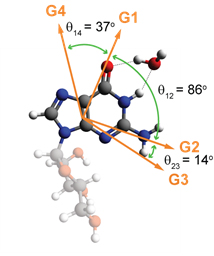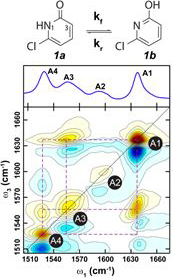
Research
| 2D IR of DNA structure | ||
|
Nucleic acids (DNA and RNA) can adopt various secondary structures
by forming hydrogen-bonds between the nucleic acid bases.
These secondary structures such as double helices,
stem-loops, pseudoknots, and G-quadruplexes
are responsible for different functions
during biological processes like DNA replication,
packaging, and transcription.
Much like our ongoing research on protein folding dynamics,
we are interested in the mechanisms of nucleic acid folding.
What structural motifs are in the folded structure?
What are the disordered states?
What are the timescales of the distinct folding events?
How does the solvent influence the folding?
Such questions can be addressed through vibrational spectroscopy
as a result of its sensitivity to base-pairing,
sugar conformation,
and glycosidic torsion angles.
Our research group is developing 2D IR spectroscopy
to address questions such as these
regarding the structure and dynamics of DNA. “Anharmonic Vibrational Modes of Nucleic Acid Bases Revealed by 2D IR Spectroscopy”, C. S. Peng, K. C. Jones, and A. Tokmakoff, J. Am. Chem. Soc. 133, 15650 (2011). |
 |
|
| Tautomerization of aromatic heterocycles | ||
|
Tautomerization of DNA base-pairs from the canonical keto-amino form to keto-imino form has been proposed to lead to spontaneous mutation. The major limitation in studying tautomerism is the lack of experimental techniques which have high structural sensitivity and fast time resolution to detect rapidly inter-converting species. We have used 2D IR spectroscopy to identify spectral signatures and distinctive cross-peak patterns of the lactam and lactim tautomers of pyridone derivatives in aqueous solution. We seek to develop methods to measure the tautomerization kinetics and investigate the mechanisms. “Identification of lactam-lactim tautomers of aromatic heterocycles in aqueous solution using 2D IR spectroscopy”, C. Sam Peng and A. Tokmakoff, J. Phys. Chem. Lett. 3, 3302-3306 (2012). |
 |
|